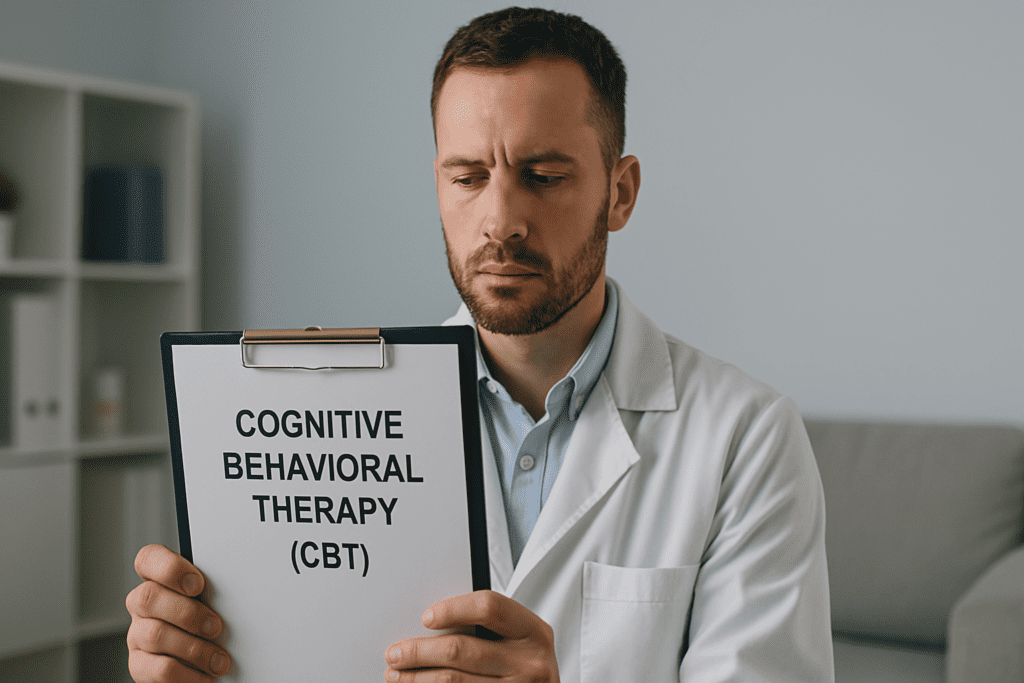Understanding CBT and Its Unique Role in Anxiety Treatment
Cognitive Behavioral Therapy (CBT) has become one of the most widely researched and recommended forms of psychotherapy, particularly when it comes to treating anxiety disorders. Rooted in the connection between thoughts, feelings, and behaviors, CBT provides individuals with practical tools to identify and modify the patterns that contribute to anxiety. Unlike some traditional forms of therapy that focus heavily on the past, CBT emphasizes the present and offers solutions that can be implemented in real time, giving clients the power to challenge irrational fears and reduce anxiety symptoms.
You may also like: How Does CBT Work to Improve Relationships and Communication? Science-Backed Techniques for Getting Along with Others
For individuals struggling with persistent worry, panic attacks, or generalized anxiety, cognitive behavioral therapy offers a structured and evidence-based approach that goes beyond temporary relief. What makes CBT especially effective is its collaborative nature; clients are not passive recipients but active participants in identifying triggers and developing strategies to cope. This empowers them to take control of their emotional responses and reduce the cycle of anxious thinking.
Moreover, CBT for anxiety disorders is not a one-size-fits-all solution. Therapists tailor techniques to each client’s unique thought patterns and emotional responses. This flexibility makes CBT especially effective across a wide spectrum of anxiety-related conditions, including social anxiety disorder, panic disorder, specific phobias, and generalized anxiety disorder (GAD). By focusing on the interplay between cognition and behavior, CBT method anxiety treatments are designed to disrupt the negative feedback loops that often maintain anxious states.
An important distinction of CBT is its focus on skill-building. Patients learn specific methods for calming the mind and body in moments of acute distress. These are not abstract concepts but actionable interventions that can be practiced, refined, and applied in everyday life. This makes CBT therapy for anxiety especially appealing for those seeking autonomy in managing their mental health.
Finally, CBT’s credibility is supported by a robust body of scientific evidence. Numerous studies have validated its effectiveness not only in reducing anxiety but also in preventing relapse. This long-term value positions cognitive behavioral therapy as one of the most reliable and respected approaches in modern mental health care.
The Psychological Mechanisms of Anxiety: Why CBT Is Especially Effective
Anxiety disorders are complex, involving both psychological and physiological responses to perceived threats. When the brain perceives danger—real or imagined—it triggers a cascade of reactions including elevated heart rate, muscle tension, rapid breathing, and intrusive thoughts. The fight-or-flight response, while evolutionarily designed to protect us, becomes maladaptive when constantly activated by everyday stressors. This is where CBT’s targeted approach becomes invaluable.
CBT for anxiety disorders operates on the premise that distorted thinking patterns play a central role in perpetuating anxiety. Individuals with anxiety often engage in cognitive distortions—automatic thoughts that are irrational and pessimistic. Examples include catastrophizing (“What if the worst happens?”), overgeneralization (“This always happens to me”), and mind reading (“They must think I’m stupid”). These distortions can escalate anxiety, creating a vicious cycle of fear and avoidance.
Cognitive therapy for anxiety works to disrupt this cycle by encouraging individuals to evaluate the evidence for their thoughts, identify biases, and reframe beliefs in a more balanced way. This process, known as cognitive restructuring, is a cornerstone of CBT cognitive restructuring techniques. Over time, clients begin to notice a shift in their internal dialogue. Thoughts that once triggered panic begin to lose their grip, replaced by more grounded interpretations of events.
In addition to its cognitive component, CBT includes behavioral strategies that further reinforce calm and control. Exposure therapy, for example, is commonly used within the CBT framework to help individuals gradually face feared situations in a safe and controlled manner. This technique helps desensitize the anxiety response and build confidence in one’s ability to tolerate discomfort.
What makes CBT especially suited to treating anxiety is its dual focus on the mind and behavior. By addressing both the thought processes that trigger anxiety and the behaviors that maintain it, CBT offers a holistic treatment model. Clients are not just learning to think differently; they are also practicing new behaviors that reinforce a calmer, more confident mindset.
How Cognitive Restructuring Rewires the Anxious Mind
Cognitive restructuring is perhaps the most transformative element of cognitive behavioral therapy anxiety treatment. At its core, this technique helps individuals challenge the automatic negative thoughts that fuel anxiety and replace them with more accurate, constructive alternatives. The process is both logical and compassionate—it recognizes that while our thoughts may feel real, they are not always rooted in reality.
The power of cognitive restructuring lies in its ability to reshape the way the brain processes information. Anxious individuals often operate under maladaptive core beliefs, such as “I’m not safe,” “I can’t handle uncertainty,” or “If I make a mistake, I’ll be rejected.” CBT cognitive restructuring targets these beliefs by encouraging clients to examine the evidence, consider alternative perspectives, and experiment with new interpretations.
For example, someone with social anxiety may fear being judged during a presentation. Using cognitive behavioral therapy, they would be guided to ask questions such as, “What is the likelihood that everyone will think negatively of me?” or “Even if I do make a mistake, does that mean I’m incompetent?” This method does not simply replace negative thoughts with positive ones—it fosters realistic thinking, which is a much more sustainable and credible alternative for those with anxiety.
Importantly, these shifts are not just intellectual exercises. As individuals repeatedly challenge and change their thinking patterns, the brain begins to form new neural pathways. This neuroplasticity allows for lasting change in how stress and uncertainty are interpreted. Over time, the anxious brain becomes less reactive and more reflective.
Cognitive therapy for anxiety disorders also integrates tools like thought records and belief charts to help individuals track their cognitive distortions and monitor their progress. These tools provide concrete evidence that change is occurring, reinforcing motivation and a sense of agency.
Cognitive restructuring is not a quick fix, but it is a deeply empowering process. It teaches individuals that while they cannot always control what happens to them, they can control how they interpret and respond to those events. In doing so, it lays the foundation for long-term emotional resilience.
The Role of Behavioral Interventions in Reducing Avoidance and Fear
While cognitive techniques are central to CBT, the behavioral component plays an equally critical role in anxiety treatment. Avoidance is one of the primary ways anxiety maintains its grip on individuals. When people avoid what they fear—whether it’s public speaking, driving, or even making phone calls—they inadvertently reinforce the belief that the feared situation is dangerous. CBT helps break this cycle through a series of structured behavioral interventions.
One of the most widely used strategies is exposure therapy, a gradual and intentional process of facing feared stimuli in a controlled environment. The idea is not to overwhelm the client, but to slowly desensitize them to the triggers that provoke anxiety. Over time, repeated exposure without the anticipated negative outcome leads to what psychologists call “habituation,” a natural reduction in fear response.
Behavioral therapy for anxiety disorders also includes activity scheduling, behavioral experiments, and problem-solving training. Activity scheduling involves re-engaging with activities that have been avoided due to anxiety. Behavioral experiments test out feared beliefs in real-world situations—for example, initiating small talk with a stranger to challenge the assumption that social interaction will always lead to embarrassment.
These behavioral techniques are essential for building confidence and reducing reliance on avoidance as a coping mechanism. They help clients collect real-life evidence that contradicts their catastrophic predictions, thereby weakening the grip of anxiety over time.
Cognitive behavioral treatment for anxiety integrates these interventions with cognitive techniques, ensuring that insights gained in therapy translate into action. This dual approach allows clients to practice new behaviors while simultaneously developing a more balanced perspective on their fears.
What makes behavioral interventions especially powerful is their potential for generalization. Once a client succeeds in one feared situation, they often find it easier to tackle others. This creates a snowball effect of confidence, reinforcing the belief that they are capable of handling discomfort and uncertainty.

CBT in the Moment: Techniques for Managing Acute Anxiety
One of the most compelling benefits of CBT is its emphasis on developing in-the-moment anxiety skills. These techniques empower individuals to respond to anxiety as it arises, rather than feeling helpless in the face of sudden panic or overwhelm. Known as “distress tolerance” or “coping skills,” these strategies can be deployed anytime, anywhere, providing immediate relief.
A key technique within the CBT method for feeling less anxious is diaphragmatic breathing, also known as belly breathing. This activates the body’s parasympathetic nervous system, signaling the brain to relax. Unlike shallow chest breathing, diaphragmatic breathing promotes a sense of groundedness and calm. It is often paired with mindfulness practices that encourage individuals to observe their thoughts without judgment, further reducing anxiety.
Another effective tool is grounding, a practice that helps anchor the mind in the present moment. This might include focusing on physical sensations (like feeling the ground beneath your feet), reciting calming statements, or engaging the five senses to redirect attention away from intrusive thoughts. CBT in the moment anxiety skills like these are practical, portable, and easy to learn.
Cognitive defusion, borrowed from Acceptance and Commitment Therapy but integrated into CBT, is another helpful method. It involves distancing oneself from distressing thoughts rather than getting entangled in them. For example, instead of thinking “I’m going to mess this up,” clients are encouraged to say, “I’m having the thought that I’m going to mess this up.” This subtle shift reduces the power of anxious thoughts and creates space for more intentional action.
Journaling can also be a powerful in-the-moment tool. Writing down thoughts and feelings allows individuals to externalize their anxiety, identify patterns, and apply cognitive restructuring techniques. It is especially useful during periods of heightened emotional distress when verbal processing may not be accessible.
Collectively, these CBT techniques for anxiety provide more than temporary comfort—they lay the groundwork for emotional regulation. When individuals have tools they can rely on in the moment, they are more likely to face challenges with confidence rather than avoidance, reinforcing long-term recovery.
Evidence and Outcomes: Does CBT Work for Anxiety?
When it comes to answering the question, “Does CBT work for anxiety?” the scientific consensus is a resounding yes. CBT is one of the most thoroughly researched forms of psychotherapy, and its efficacy in treating anxiety has been validated across hundreds of randomized controlled trials. These studies consistently demonstrate that CBT significantly reduces symptoms in a wide range of anxiety disorders, often outperforming medication and other forms of therapy.
In particular, CBT shows strong outcomes for generalized anxiety disorder, panic disorder, social anxiety, and phobias. Cognitive behavioral therapy CBT for anxiety not only helps reduce the severity of symptoms but also equips individuals with skills to prevent relapse. This makes it a sustainable and long-term solution, not just a short-term fix.
One of the reasons CBT is so effective lies in its adaptability. Therapists can tailor interventions based on the client’s unique fears, personality traits, and learning style. Whether the treatment emphasizes cognitive restructuring, exposure therapy, or mindfulness-based techniques, the core principles remain the same: challenge distorted thinking and encourage behavior that aligns with personal values.
Clinical data also suggest that CBT may enhance brain function. Neuroimaging studies show that after CBT treatment, patients often display changes in brain regions involved in emotional regulation, such as the amygdala and prefrontal cortex. This provides compelling biological evidence of CBT’s impact—not only does it change how people think, but it also changes how their brains process anxiety.
Moreover, CBT’s emphasis on skill-building and self-efficacy contributes to its lasting effects. Clients often report feeling more confident, resilient, and autonomous after completing therapy. They no longer see anxiety as an enemy to be feared but as a manageable part of life that they are equipped to handle.
In short, the question is not “can CBT help with anxiety,” but rather “how can we make CBT more accessible to those who need it most?”
Reclaiming Your Life: How CBT Helps You Regain Calm and Control
Living with anxiety can feel like being trapped in a maze with no clear exit. Everyday decisions become sources of stress, relationships suffer, and even moments of rest can feel intrusive. But cognitive behavioral therapy offers a path out—a structured, evidence-based approach that gives you the tools to reclaim calm and control over your life.
What sets cognitive behavioural therapy for anxiety disorders apart is its empowering philosophy. Rather than viewing anxiety as something to avoid or suppress, CBT teaches you to understand, face, and ultimately master it. This mindset shift is revolutionary for many clients who have spent years believing they were powerless against their fears.
CBT interventions for anxiety are not about perfection; they are about progress. Every time you challenge a fearful thought, step into an avoided situation, or apply a coping skill in real-time, you are reinforcing your capacity to grow. These small wins accumulate, reshaping your identity from someone overwhelmed by anxiety to someone equipped to handle life’s challenges with courage and clarity.
Ultimately, CBT is not just about feeling better—it’s about functioning better. It’s about showing up to your life in ways you couldn’t before: attending that event, making that phone call, pursuing that goal. With CBT, you’re not just reducing symptoms; you’re expanding possibilities.

Frequently Asked Questions (FAQ): CBT for Anxiety Disorders
1. Can CBT help with anxiety even if I’ve had symptoms for years?
Yes, CBT therapy for anxiety can still be highly effective even if you’ve struggled for a long time. Many people mistakenly assume that chronic anxiety becomes “hardwired” and untreatable, but anxiety cognitive behavioral treatments work by targeting the thought and behavior patterns that sustain long-term distress. Cognitive behavioural therapy for anxiety disorders is structured to help patients recognize how even deeply ingrained responses can be challenged and reshaped. In fact, individuals with longstanding anxiety often experience “aha” moments through CBT cognitive restructuring, where they realize how habitual thought patterns have quietly reinforced their fears. Whether your symptoms are recent or longstanding, CBT interventions for anxiety are built to meet you where you are—offering tools that remain relevant no matter how long anxiety has been present.
2. What makes CBT different from other types of therapy for anxiety?
Unlike purely talk-based therapies, cognitive behavioral therapy anxiety strategies are grounded in measurable, action-oriented change. CBT for anxiety disorders focuses on identifying specific thought distortions and systematically replacing them with healthier beliefs. While traditional approaches may explore root causes in depth, CBT for anxiety prioritizes present-day coping and symptom relief, which often leads to faster functional improvement. The cbt method anxiety programs are also backed by decades of research and offer a flexible toolkit, including cognitive restructuring, exposure exercises, and behavioral activation. What sets CBT apart is its structured, educational model—it empowers clients to become their own therapists, fostering long-term resilience against future anxiety flare-ups.
3. Are there any lesser-known CBT techniques for anxiety that people often overlook?
Absolutely—some of the most powerful CBT techniques for anxiety are surprisingly simple yet underused. For example, imagery rescripting is a cognitive therapy for anxiety approach that helps rewrite past traumatic memories by actively imagining them with new outcomes. Another technique is “behavioral experiments,” where clients test out feared predictions in real life, which helps dismantle cognitive distortions through experience. These go beyond typical journaling or thought-challenging exercises, adding emotional depth and experiential learning to the CBT method for feeling less anxious. Additionally, CBT in the moment anxiety skills, such as urge surfing and anchor statements, offer immediate relief when panic arises unexpectedly. These strategies often fly under the radar but provide deep, evidence-backed benefits for people with both generalized and situational anxiety.
4. How can I apply CBT in real time when anxiety hits suddenly?
When anxiety strikes unexpectedly, applying CBT in the moment anxiety skills can interrupt the spiral before it intensifies. One technique is “name it to tame it,” where you label the anxious thought and then reframe it using cognitive behavioral treatment for anxiety patterns you’ve practiced. Another is to challenge catastrophic thinking with probability estimates—asking yourself how likely your worst fear is and what the best or most realistic outcome might be. These micro-interventions reflect how CBT therapy for anxiety doesn’t require a therapist present to be effective; it can become a reflexive skillset. Regular practice strengthens neural pathways, making it easier to replace panic with perspective. Behavioral therapy for anxiety trains your brain to pause, assess, and respond—rather than react automatically.
5. What role does exposure play in cognitive behavioral therapy for anxiety disorders?
Exposure is a core component of behavioral therapy for anxiety disorders, especially for phobias, social anxiety, and panic disorder. Through gradual, intentional confrontation of feared situations, CBT techniques for anxiety teach your brain that avoidance actually strengthens fear, while exposure reduces it. This process, called habituation, retrains the nervous system to stop overreacting to perceived threats. In cognitive behavioral therapy cbt for anxiety, exposure is never about “just pushing through”—it’s a carefully graded approach tailored to your tolerance level. Over time, exposure exercises paired with cognitive restructuring create lasting emotional flexibility and self-trust, key ingredients for overcoming chronic fear responses.
6. Does cognitive behavioral therapy work for anxiety in children and teens?
Yes, CBT cognitive restructuring and behavioral therapy for anxiety are highly effective in children and adolescents, especially when tailored to developmental levels. Kids often benefit from more visual and interactive approaches—like using cartoons to identify thought distortions or games that reward facing fears. Anxiety disorder cognitive behavioral therapy for youth typically includes strong parental involvement to reinforce skills at home. It’s particularly helpful in addressing school avoidance, separation anxiety, and performance-related stress. With early intervention, cognitive treatment for anxiety in young people can prevent long-term mental health struggles and build resilience well into adulthood.
7. How does CBT help with anxiety that’s tied to perfectionism or self-criticism?
Cognitive therapy for anxiety disorders is especially well-suited for perfectionistic thinking, which often fuels chronic worry and self-doubt. Through the CBT method anxiety framework, clients learn to challenge all-or-nothing beliefs and replace them with more compassionate self-appraisals. One powerful technique is the “double-standard method,” where you compare how you treat yourself to how you’d treat a close friend. This reframing process is a cornerstone of anxiety cognitive behavioral work and helps reduce internal pressure without compromising motivation. CBT cognitive restructuring also teaches that mistakes are not threats to identity but opportunities for learning—shifting the entire emotional context around success and failure.
8. What happens if CBT doesn’t work for my anxiety? Are there alternatives?
While CBT for anxiety disorders has a strong success rate, it’s not a one-size-fits-all solution. Some people may find that adding mindfulness-based approaches, such as ACT (Acceptance and Commitment Therapy), enhances the effectiveness of core CBT methods. Others benefit from combining CBT with pharmacological support or alternative therapies like EMDR, especially when trauma is a contributing factor. However, before concluding that CBT didn’t work, it’s important to assess whether the treatment was delivered properly—CBT therapy for anxiety must be consistent, structured, and customized to the individual. If your therapist didn’t use evidence-based CBT interventions for anxiety or if sessions lacked goal-setting, the issue may lie in the approach, not the method. Exploring a new provider with stronger training in cognitive behavioral therapy anxiety practices might change the outcome.
9. How does CBT address physical symptoms like insomnia or stomachaches from anxiety?
Cognitive behavioral therapy anxiety strategies don’t just address thoughts—they also help regulate the physical manifestations of anxiety. For example, CBT method for feeling less anxious may include sleep hygiene protocols for insomnia and interoceptive exposure to desensitize the body to anxiety-linked sensations. CBT cognitive restructuring helps reduce the fear of symptoms themselves, which often fuels a feedback loop of worsening physical discomfort. Behavioral therapy for anxiety can also incorporate pacing, grounding, and progressive muscle relaxation to teach the nervous system how to downshift. By treating mind and body as an integrated system, cognitive therapy treatment for anxiety becomes a comprehensive toolkit—not just a mental one.
10. What does the future of CBT look like for anxiety treatment?
Emerging innovations in CBT therapy for anxiety are harnessing technology to improve accessibility and personalization. AI-guided CBT apps now offer real-time feedback, while virtual reality exposure is being used to treat phobias and social anxiety in controlled environments. These tools allow anxiety cognitive behavioral techniques to reach more people, including those in underserved areas. In addition, researchers are refining cognitive behavioral treatment for anxiety to account for cultural and neurodiversity differences, ensuring it’s inclusive and relevant. As neuroscience deepens our understanding of emotion regulation and cognitive processing, future CBT interventions for anxiety will likely become even more precise—offering hyper-targeted solutions based on individual brain-behavior profiles.

Final Thoughts: Why CBT Is the Gold Standard for Anxiety Treatment
In the realm of anxiety treatment, cognitive behavioral therapy stands as a gold standard—not because it offers a quick fix, but because it provides a deep, sustainable transformation. The structured yet flexible nature of CBT allows it to adapt to individual needs while staying rooted in evidence-based principles. Whether you’re seeking cognitive therapy treatment for anxiety, exploring behavioral therapy for anxiety, or simply wondering how CBT can fit into your journey, the answer is that CBT equips you with the skills and strategies to take back control of your life.
With its emphasis on understanding thought patterns, changing behavior, and mastering in-the-moment coping skills, CBT offers far more than symptom management. It delivers a roadmap to recovery—one that is guided by science, experience, and trust in your ability to heal. When practiced with dedication and support, CBT not only relieves anxiety but also fosters a lasting sense of calm, confidence, and personal empowerment.
managing anxiety with therapy, therapy for stress and anxiety, mental health coping strategies, overcoming chronic worry, emotional regulation skills, talk therapy for anxiety, psychological treatment for anxiety, panic attack therapy options, stress management therapy, trauma-informed therapy techniques, fear reduction methods, mental wellness practices, guided self-help therapy, anxiety and brain function, resilience building therapy, therapy for intrusive thoughts, anxiety desensitization techniques, emotional resilience training, thought reframing strategies, therapy for overthinking
Further Reading:
Cognitive-behavioral therapy for anxiety disorders
The Effectiveness of Cognitive Behavioral Therapy (CBT) in Anxiety Management
How it works – Cognitive behavioural therapy (CBT)
Disclaimer
The information contained in this article is provided for general informational purposes only and is not intended to serve as medical, legal, or professional advice. While Health11News strives to present accurate, up-to-date, and reliable content, no warranty or guarantee, expressed or implied, is made regarding the completeness, accuracy, or adequacy of the information provided. Readers are strongly advised to seek the guidance of a qualified healthcare provider or other relevant professionals before acting on any information contained in this article. Health11News, its authors, editors, and contributors expressly disclaim any liability for any damages, losses, or consequences arising directly or indirectly from the use, interpretation, or reliance on any information presented herein. The views and opinions expressed in this article are those of the author(s) and do not necessarily reflect the official policies or positions of Health11News.


